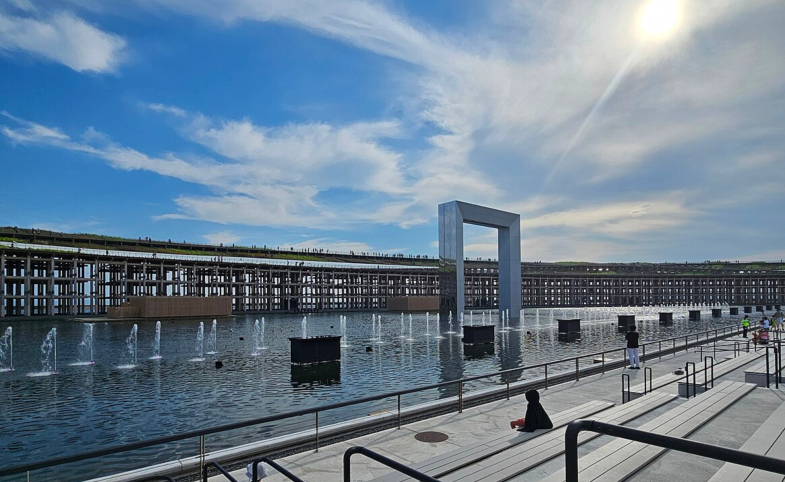The CPD Blog is intended to stimulate dialog among scholars and practitioners from around the world in the public diplomacy sphere. The opinions represented here are the authors' own and do not necessarily reflect CPD's views. For blogger guidelines, click here.

Looking for God at the Osaka Expo
This article is part of a series by CPD Faculty Fellow Nicholas Cull, exploring the treatment of religious issues at World Expos. Previous articles reported on expos in Dubai, Milan, and Shanghai.
Expos have historically been locations at which nations share their culture with one another. These mega events have historically seen the presentation of cultural objects as diverse as the Barcelona chair of Mies van der Rohe (1929) and Picasso’s painting Guernica (1937). They are festivals of food, music, language and sometimes politics but what of the core of culture: religion? It is always fascinating to see whether and how this particular building block of culture is addressed at expos. I have found that it shifts from time to time and place to place, and have previously used it as a window on the participants self-presentation. 2025’s expo in Osaka was no exception.
Japanese culture has a famously idiosyncratic relationship with religion. While both Shinto and Buddhism have a place in Japan’s public life, a Pew poll in 2023 found that 43% of Japanese people have no religious affiliation and only 6% consider religion important. Perhaps because of this, many national pavilions simply skirted the issue to avoid their own faith serving as a point of dissimilarity or even a cause of alienation. There was nothing religious in either the U.S. or UK or Austria, Czechia, Germany, Poland, Portugal, or Spain. The architecturally impressive Gulf pavilions of Saudi, UAE, Bahrain, and Qatar played down their respective country’s religious aspects. Switzerland included churches in silhouette, its great papercut wall of Swiss things, along with cheese and Roger Federer. China included representations of Buddhist religious exchange among carved friezes of great moments in Sino-Japanese history, which lined one hallway; and India had a small picture of the tree under which Buddha achieved enlightenment, but all were easily missed. Others, however, chose a different strategy and steered into religion as a theme. None more than Italy and France.
The most explicitly religious display at the Osaka Expo was that of Italy, which chose to collaborate with the Vatican to display a series of masterpieces of religious art including Caravaggio’s monumental painting of the deposition of Christ, Michelangelo’s sculpture, Risen Christ, and Perugino's painting of the Virgin and child known as the Banner of Justice (exhibited abroad for the first time). From the classical era, there was also a magnificent Roman rendering of Atlas. Yet the relic that drew greatest attention (or slowed crowds for most cellphone photographs) was secular: pages from Leonardo’s Codex Atlanticus. The Japanese were impressed by the whole Italian show. Religion was part of the spectacle and part of the attraction of the exotic. Locals queued for hours to get into the pavilion and then to move around inside.
France, in contrast, handled the issue of religion in a creative way. While most of the French pavilion was an exquisite celebration of exportable items – Luis Vuitton, Christian Dior, Alsace wine – one hall drew parallels between Japanese and French sacred buildings. Models of Notre Dame and Mont Saint-Michel were presented beside models of similarly venerated Japanese locations like Shuri Castle or the seaside Itsukashima Shrine. The parallels were especially powerful when one realized that both Notre Dame and Suri Castle suffered devastating fires in the same year: 2019. Visitors could see charred relics from both. The final exhibit of this section showed the French-administered island of Bora-Bora in the context of a shared devotion to the ecological wellbeing of the Pacific. The entire French pavilion was entitled "a hymn to love" which appropriated a religious term but was really a hymn to France.
Israel had a tiny corner of a common hall, but emphasized its religious culture with a stone from the Hasmonean fortress in Jerusalem onto which bible verses were projected. A computer interface told the story of the Western Wall and invited visitors to submit a prayer. Many visitors prayed for peace. A lamp unearthed on the Mount of Olives was shown along with the verse from Genesis 22, a divine promise to Abraham: "and through you all the families of the earth shall be blessed." The rest of the display was an argument that Israeli tech start-ups and health innovations were the fulfilment of this prophesy of blessing. The slogan on the outer wall: "Israel – harmony" fell awkwardly on the eye of 2025. Palestine also presented views of the Temple Mount but in the context of a tourist attraction. Leaflets in its area revealed their own hopes for sustaining trade links with Japan. So similar but so far apart. Of the remaining explicitly religious nations, Romania and Armenia both asserted the foundational role of Christianity in their respective national lives. Armenia introduced itself as the first Christian country while Romania included religious images in its national montage and mentioned Christian resistance to the Turks and the value of one particular artist’s ‘spiritual resistance’ during the 1950s. None of these seemed to resonate or detain visitors.
Several countries successfully tied religion into the themes of the Expo by drawing universal points from their religious heritage. They related present commitment to sustainability to the wisdom of their ancient forebears. Japan and China both made this connection in their pavilions. The main rubric for the Expo noted: "For Japanese people, every substance, be it of human, animal, vegetable or mineral origin, 'carries life within it.'" Australia’s offering was built around the culture of indigenous Australians. Ireland celebrated its pre-Christian monuments and insights. France mentioned the environmental stewardship of the people of Bora-Bora. Oman rooted its contemporary water management in insight from the Holy Koran (Surah Al-Anbiya, 21:30): "the origin of every living thing is in water."
Some countries emphasized their religious diversity. Canada had a native religious ceremony among the scenes discoverable in its augmented reality display. Türkiye had a nice documentary about its varied past, but it was a matter of luck whether it was playing when one went through the pavilion, as fashion and textiles were also celebrated on the screen. Azerbaijan emphasized its diversity in its national montage movie mentioning the Catholic church in Baku and showing scenes in a synagogue. There was no mention of the state’s recent treatment of its Armenian minority. Philippines described itself as a "tapestry woven together" while Malaysia was a jointly woven tree. Malta created a gem of a pavilion, which included religious elements of its culture from ancient pre-Christian temples through a biblical shipwreck (including an animated St. Paul); through the Knights of Malta to a colorful contemporary religious observance. It was all just lovely and made me keen to visit Malta soon, which is part of the purpose.
"I was left feeling that Expo 2025 Osaka was a welcome pause to reconnect with the best in ourselves and others and to experience – if only for a moment – the world as God or your own equivalent, intended."
Other countries presented objects of shared cultural significance to both themselves and Japan as if they were religious relics. These included Czechia with original papers by father of genetics, Gregor Mendel, and Colombia, with the typewriter of Gabriel Garcia Marquez. Ukraine’s pavilion -- "Ukraine Not for Sale" -- presented items from the country like goods in a shop: scan the bar code and read the nature of Ukrainian life in the third year of its war for survival. Actual objects scarred by war sat at the entrance connecting the visitor to the materiality of that cruel war. The U.S. displayed a rock from the moon repeating an exhibit that had been a sensation at the Osaka Expo of 1970. China sought to top this with dust brought back from the dark side of the moon and Japan offered slices from a Martian meteor which visitors were invited to touch. While the moon rock had a special significance for families with memories of 1970 and Ukraine’s broken objects gave pause, the most appreciated original of 2025 was the 22 tons of sand shipped to Osaka from Jordan’s Wadi Ram to form the floor of that country’s immersive film room. Both the sense of connection to the country and the guide’s spirited description of the logistical challenge of bringing it through Japanese import controls were clearly much appreciated by visitors.
For me, the most moving explicitly religious display was a short documentary film screened in the Indonesian pavilion and created by one of that country’s best-known directors – Garin Nugroho – which profiled a shadow puppet master. The puppeteer explained his view of an interconnected world and the sacred significance of his performance, beginning and ending in a prayer. There was a special feeling of common insight in hearing an Indonesian puppeteer say for himself in his own language that "all the world’s a stage" like Shakespeare before him. I watched the film many times through, and not just to take advantage of the air conditioning.
In some ways attending an expo is a religious experience. It can play out like a pilgrimage with moments of togetherness and personal insight intertwined with a level of discomfort and personal sacrifice that arguably serve to elevate the significance of encounters. Two pavilions played out explicitly like pseudo religious ceremonies. In the Netherlands Pavilion, each visitor carried a glowing orb past displays about sustainability into a final chamber when they were asked to each raise their personal light and promise to be part of the solution in a common collective dawn. Luxembourg also had a room in which collective energies were symbolically gathered and sent into common effort. Both had lines so long that they took longer access than taking a flight to the country from most locations in Europe. Luxembourg reputedly hit five hours on Sunday, September 7, 2025.
If one had only the Osaka Expo to use for evidence, one would conclude that in the year 2025, human faith was divided between old principles of balance and respect for the circle of life and a great almost messianic hope that technology would somehow deliver utopia. Many pavilions included films in which time traveling adolescent girls glimpse a better future in the company of a magical companion (UK) or robot (Taiwan/Techworld) or both (Kuwait). (Taiwan, for political reasons, was represented away from the national pavilion area and under the name "Techworld." Its exhibits sought to brand Techworld as a beautiful place which made many of the world’s computer chips.)
But perhaps pavilions are the wrong place to look for a sense of the spiritual. Maybe the people of the Expo offered the glimpse of something higher: the exhibitors and guides who came together from around the world, and the curious, patient people of the Kansai region of Japan, who waited for hours in extreme heat to see what the foreigners had to share. With all participants emphasizing the value of exchange and the "spirit of expo," perhaps there was something sacred about the whole event. I was left feeling that Expo 2025 Osaka was a welcome pause to reconnect with the best in ourselves and others and to experience – if only for a moment – the world as God or your own equivalent, intended.
Visit CPD's Online Library
Explore CPD's vast online database featuring the latest books, articles, speeches and information on international organizations dedicated to public diplomacy.
POPULAR ARTICLES
-
November 3
-
November 5
-
November 13
-
October 16
-
October 16
Join the Conversation
Interested in contributing to the CPD Blog? We welcome your posts. Read our guidelines and find out how you can submit blogs and photo essays >.









